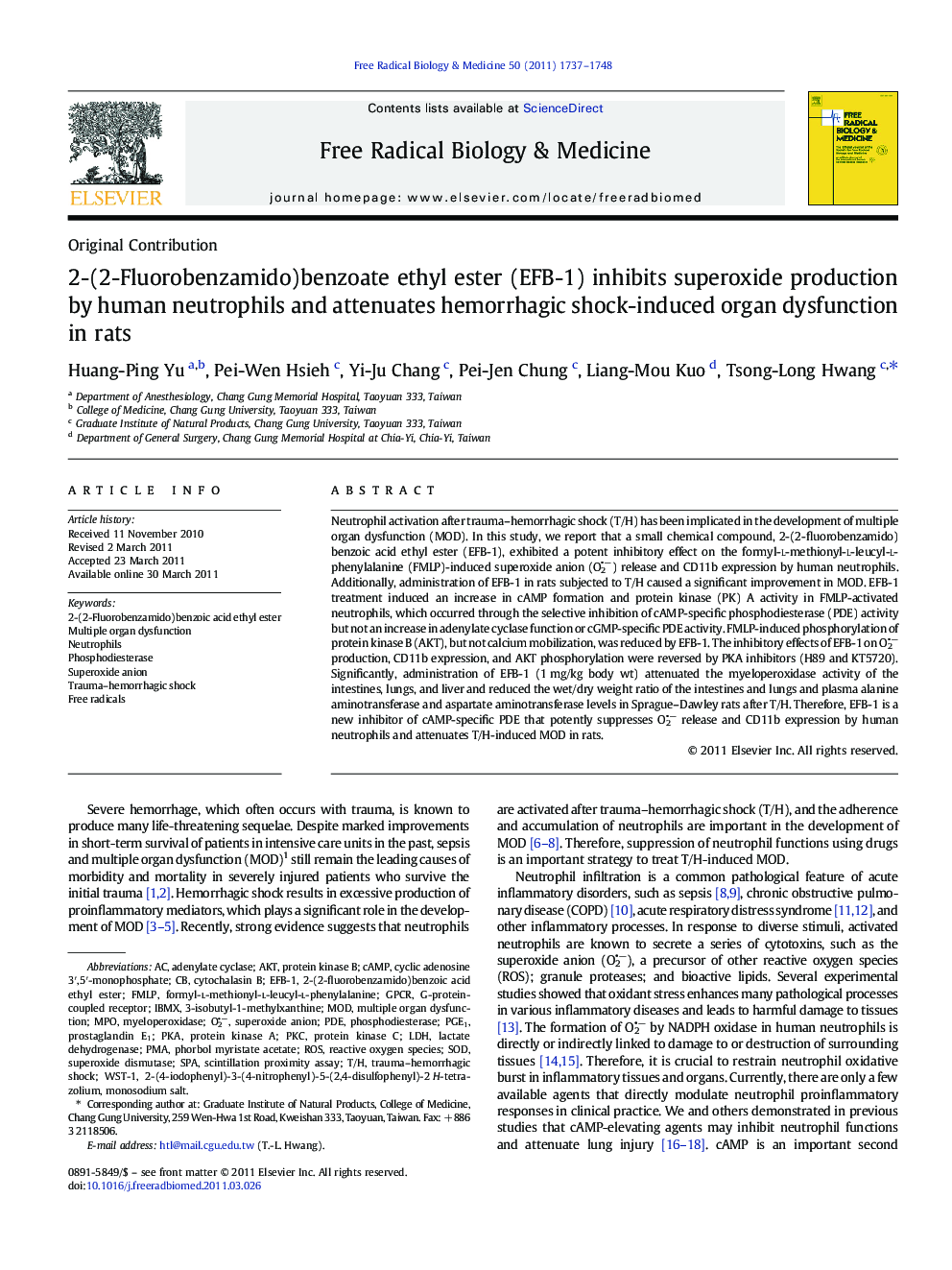| Article ID | Journal | Published Year | Pages | File Type |
|---|---|---|---|---|
| 8271767 | Free Radical Biology and Medicine | 2011 | 12 Pages |
Abstract
Neutrophil activation after trauma-hemorrhagic shock (T/H) has been implicated in the development of multiple organ dysfunction (MOD). In this study, we report that a small chemical compound, 2-(2-fluorobenzamido)benzoic acid ethyl ester (EFB-1), exhibited a potent inhibitory effect on the formyl-l-methionyl-l-leucyl-l-phenylalanine (FMLP)-induced superoxide anion (O2
- â) release and CD11b expression by human neutrophils. Additionally, administration of EFB-1 in rats subjected to T/H caused a significant improvement in MOD. EFB-1 treatment induced an increase in cAMP formation and protein kinase (PK) A activity in FMLP-activated neutrophils, which occurred through the selective inhibition of cAMP-specific phosphodiesterase (PDE) activity but not an increase in adenylate cyclase function or cGMP-specific PDE activity. FMLP-induced phosphorylation of protein kinase B (AKT), but not calcium mobilization, was reduced by EFB-1. The inhibitory effects of EFB-1 on O2
- â production, CD11b expression, and AKT phosphorylation were reversed by PKA inhibitors (H89 and KT5720). Significantly, administration of EFB-1 (1Â mg/kg body wt) attenuated the myeloperoxidase activity of the intestines, lungs, and liver and reduced the wet/dry weight ratio of the intestines and lungs and plasma alanine aminotransferase and aspartate aminotransferase levels in Sprague-Dawley rats after T/H. Therefore, EFB-1 is a new inhibitor of cAMP-specific PDE that potently suppresses O2
- â release and CD11b expression by human neutrophils and attenuates T/H-induced MOD in rats.
- â) release and CD11b expression by human neutrophils. Additionally, administration of EFB-1 in rats subjected to T/H caused a significant improvement in MOD. EFB-1 treatment induced an increase in cAMP formation and protein kinase (PK) A activity in FMLP-activated neutrophils, which occurred through the selective inhibition of cAMP-specific phosphodiesterase (PDE) activity but not an increase in adenylate cyclase function or cGMP-specific PDE activity. FMLP-induced phosphorylation of protein kinase B (AKT), but not calcium mobilization, was reduced by EFB-1. The inhibitory effects of EFB-1 on O2
- â production, CD11b expression, and AKT phosphorylation were reversed by PKA inhibitors (H89 and KT5720). Significantly, administration of EFB-1 (1Â mg/kg body wt) attenuated the myeloperoxidase activity of the intestines, lungs, and liver and reduced the wet/dry weight ratio of the intestines and lungs and plasma alanine aminotransferase and aspartate aminotransferase levels in Sprague-Dawley rats after T/H. Therefore, EFB-1 is a new inhibitor of cAMP-specific PDE that potently suppresses O2
- â release and CD11b expression by human neutrophils and attenuates T/H-induced MOD in rats.
Keywords
fMLPPKCGPCRpKaPDEMODSPAPGE1WST-1IBMXCytochalasin Bt/h3-isobutyl-1-methylxanthinecAMPMPOG-protein-coupled receptorPMAO2•−ROScyclic adenosine 3′,5′-monophosphateadenylate cyclasesuperoxide anionAktMultiple organ dysfunctionScintillation proximity assayFree radicalsSODSuperoxide dismutasephorbol myristate acetatePhosphodiesteraselactate dehydrogenaseLDHmyeloperoxidaseNeutrophilsprotein kinase Aprotein kinase BProtein kinase CProstaglandin E1Reactive oxygen species
Related Topics
Life Sciences
Biochemistry, Genetics and Molecular Biology
Ageing
Authors
Huang-Ping Yu, Pei-Wen Hsieh, Yi-Ju Chang, Pei-Jen Chung, Liang-Mou Kuo, Tsong-Long Hwang,
